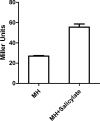Salicylate functions as an efflux pump inducer and promotes the emergence of fluoroquinolone-resistant Campylobacter jejuni mutants
- PMID: 21821741
- PMCID: PMC3194847
- DOI: 10.1128/AEM.00763-11
Salicylate functions as an efflux pump inducer and promotes the emergence of fluoroquinolone-resistant Campylobacter jejuni mutants
Abstract
Salicylate, a nonsteroidal anti-inflammatory compound, has been shown to increase the resistance of Campylobacter to antimicrobials. However, the molecular mechanism underlying salicylate-induced resistance has not yet been established. In this study, we determined how salicylate increases antibiotic resistance and evaluated its impact on the development of fluoroquinolone-resistant Campylobacter mutants. Transcriptional fusion assays, real-time quantitative reverse transcription-PCR (RT-PCR), and immunoblotting assays consistently demonstrated the induction of the CmeABC multidrug efflux pump by salicylate. Electrophoretic mobility shift assays further showed that salicylate inhibits the binding of CmeR (a transcriptional repressor of the TetR family) to the promoter DNA of cmeABC, suggesting that salicylate inhibits the function of CmeR. The presence of salicylate in the culture medium not only decreased the susceptibility of Campylobacter to ciprofloxacin but also resulted in an approximately 70-fold increase in the observed frequency of emergence of fluoroquinolone-resistant mutants under selection with ciprofloxacin. Together, these results indicate that in Campylobacter, salicylate inhibits the binding of CmeR to the promoter DNA and induces expression of cmeABC, resulting in decreased susceptibility to antibiotics and in increased emergence of fluoroquinolone-resistant mutants under selection pressure.
Figures






Similar articles
-
Regulation of the expression of the CmeABC efflux pump in Campylobacter jejuni: identification of a point mutation abolishing the binding of the CmeR repressor in an in vitro-selected multidrug-resistant mutant.FEMS Microbiol Lett. 2007 Feb;267(1):89-94. doi: 10.1111/j.1574-6968.2006.00558.x. Epub 2006 Dec 8. FEMS Microbiol Lett. 2007. PMID: 17166222
-
Genetic Basis and Functional Consequences of Differential Expression of the CmeABC Efflux Pump in Campylobacter jejuni Isolates.PLoS One. 2015 Jul 1;10(7):e0131534. doi: 10.1371/journal.pone.0131534. eCollection 2015. PLoS One. 2015. PMID: 26132196 Free PMC article.
-
Role of the CmeABC efflux pump in the emergence of fluoroquinolone-resistant Campylobacter under selection pressure.J Antimicrob Chemother. 2006 Dec;58(6):1154-9. doi: 10.1093/jac/dkl412. Epub 2006 Oct 5. J Antimicrob Chemother. 2006. PMID: 17023497
-
Fluoroquinolone-resistant Campylobacter in animal reservoirs: dynamics of development, resistance mechanisms and ecological fitness.Anim Health Res Rev. 2003 Dec;4(2):63-71. doi: 10.1079/ahr200356. Anim Health Res Rev. 2003. PMID: 15134291 Review.
-
Structures of AcrR and CmeR: insight into the mechanisms of transcriptional repression and multi-drug recognition in the TetR family of regulators.Biochim Biophys Acta. 2009 May;1794(5):844-51. doi: 10.1016/j.bbapap.2008.12.001. Epub 2008 Dec 14. Biochim Biophys Acta. 2009. PMID: 19130905 Free PMC article. Review.
Cited by
-
Spontaneous mutation frequency and molecular mechanisms of Shigella flexneri fluoroquinolone resistance under antibiotic selective stress.World J Microbiol Biotechnol. 2013 Feb;29(2):365-71. doi: 10.1007/s11274-012-1190-3. Epub 2012 Oct 16. World J Microbiol Biotechnol. 2013. PMID: 23070800
-
Dual Repression of the Multidrug Efflux Pump CmeABC by CosR and CmeR in Campylobacter jejuni.Front Microbiol. 2016 Jul 13;7:1097. doi: 10.3389/fmicb.2016.01097. eCollection 2016. Front Microbiol. 2016. PMID: 27468281 Free PMC article.
-
A novel two-component signaling system facilitates uropathogenic Escherichia coli's ability to exploit abundant host metabolites.PLoS Pathog. 2013;9(6):e1003428. doi: 10.1371/journal.ppat.1003428. Epub 2013 Jun 27. PLoS Pathog. 2013. PMID: 23825943 Free PMC article.
-
Impact of Microbiota Transplant on Resistome of Gut Microbiota in Gnotobiotic Piglets and Human Subjects.Front Microbiol. 2020 May 19;11:932. doi: 10.3389/fmicb.2020.00932. eCollection 2020. Front Microbiol. 2020. PMID: 32508773 Free PMC article.
-
FNR regulates expression of important virulence factors contributing to pathogenicity of uropathogenic Escherichia coli.Infect Immun. 2014 Dec;82(12):5086-98. doi: 10.1128/IAI.02315-14. Epub 2014 Sep 22. Infect Immun. 2014. PMID: 25245807 Free PMC article.
References
-
- Akiba M., Lin J., Barton Y. W., Zhang Q. 2006. Interaction of CmeABC and CmeDEF in conferring antimicrobial resistance and maintaining cell viability in Campylobacter jejuni. J. Antimicrob. Chemother. 57:52–60 - PubMed
-
- Domenico P., Hopkins T., Cunha B. A. 1990. The effect of sodium salicylate on antibiotic susceptibility and synergy in Klebsiella pneumoniae. J. Antimicrob. Chemother. 26:343–351 - PubMed
Publication types
MeSH terms
Substances
Grants and funding
LinkOut - more resources
Full Text Sources
Medical
Molecular Biology Databases

